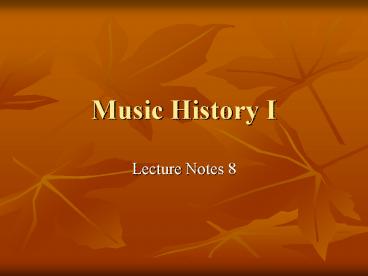Music History I - PowerPoint PPT Presentation
1 / 16
Title:
Music History I
Description:
Music History I. Lecture Notes 8. Mass for Easter Sunday. This polyphonic setting probably by L onin ... to the Holy Trinity (triple); duple divisions were ... – PowerPoint PPT presentation
Number of Views:173
Avg rating:3.0/5.0
Title: Music History I
1
Music History I
- Lecture Notes 8
2
Mass for Easter Sunday
- This polyphonic setting probably by Léonin
- From the Gradual Haec dies (Ex. 2, f., p. 4)
- The organum setting part of Magnus liber organi
- The MS reproduction on p. 67 where does the Haec
dies melody begin? - Fourth system at illuminated letter H
- Chant melody and duplum compared
- Elaborate melody moving rapidly above chant
recurrent rhythmic patterns 3rds, 4ths and 5ths
3
More on Example 10
- Use of rhythmic modes Mode 1 and Mode 6
- Features of the duplum (the added melody)
- vocal in style
- mostly stepwise (conjunct) motion
- general range a ninth overall range a tenth
- long, extended melodic line
- modal
- overall contour starts high, moves gradually
downward, finally ending on same note as at the
beginning
4
Ex. 10 2 more observations
- A responsorial chant
- Haec dies is designed that way from the
beginning to alternate soloist and chorus - Free organum/measured organum
- Haec dies is free in all sections except on the
word Domino and on the words in saeculum
5
Example 14 a 13th C. motet
- Tenor melody
- Ambitus (range) a fifth
- Overall shape rise and fall of each phrase
- Upper voices overlap the tenor
- Triplum passing tone at m. 4
- Both upper voices (m. 8 middle voice (m. 12)
- Newly composed tenor very unusual
6
Emergence of Polyphony
- This very important development marks the
beginning of a long history of multipartite music
by composers up to our day. - The earliest sources of notated polyphony date
from the 9th century. - The Musica enchiriadis (Musical Handbook)
contains the earliest known reference to
polyphony.
7
Organum
- A polyphonic work consisting of a chant melody
and at least one added voice - Examples in HMWC parallel organum in 5ths
parallel organum in four parts two-part organum
in contrary motion - John Cotton the theorist 12th century writer on
the importance of contrary motion added voices
should be independent of the borrowed melody
8
Organum (continued)
- Important cadences in music of the 12th century
resolved to 5ths, 8ves, and unisons. - Ex. 9, p. 19 (HMWC anthology) is melismatic
because there are multiple notes over the chant
melody. - The lower voice is called the tenor from the
Latin tenere (to hold)
9
Two Centers for Music
- Abbey of St. Martial
- A center for the production and collection of
medieval chant - Cathedral of Notre Dame
- The corner stone was laid in 1163
- Became one of the most productive centers for
the composition and preservation of church music
10
The Rhythmic Modes
- 12th century composers inspired by poetry
11
Léonin the Mentor
- Perotin, the student, added a third (sometimes a
fourth) voice to the tenor in his compositions
12
Clausula
- Can be seen as a form of glossing
- Definition Clausulae are brief polyphonic
sections of discant organum interpolated into a
larger existing work. - The clausula is not an independent piece to be
performed on its own. - Performers were often free to substitute any
clausula desired or in any combination
13
Development of the Motet
- When a new text was added to the duplum of an
existing clausula and performed as a separate
work outside the church, the result was the
motet. - The Montpellier Codex contains 336 works of
music, most of which are motets a collection of
layers of parchment that date from the 1270s to
the early 14th century
14
The Motet in Production and Performance
- Reached a high level of popularity around the
year 1230 - Johannes de Grocheo maintained that motets should
be performed in the presence of learned persons
15
Conductus
- From one to four voices
- Texts taken from freely composed poems
- Not based on any borrowed material
- May be monophonic or polyphonic
- In polyphonic versions all voices move in
generally the same rhythm - Note-against-note writing a distinctive feature
- From conducere (to escort)
- Coda Structural section at the end of some
compositions comes from the Latin word cauda
(tail)
16
Mensural Notation
- The need for a more precise system for rhythmic
variety was the driving force behind the gradual
transition from the more restrictive rhythmic
modes - The system was based on principles set down by
Franco of Cologne (Franconian Notation) - Franco divided the Long and the Breve based on
the rule that perfect related to the Holy Trinity
(triple) duple divisions were imperfect - Petrus de Cruce carried the system further
through a greater subdivision of the breve
(Petronian Notation)































